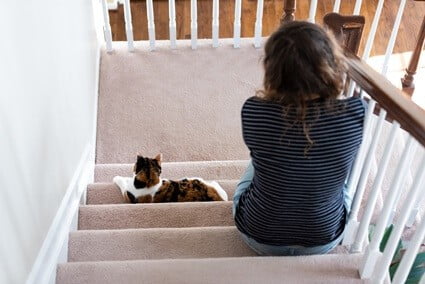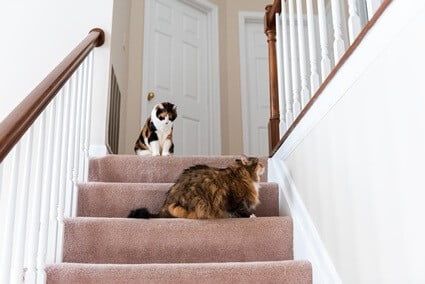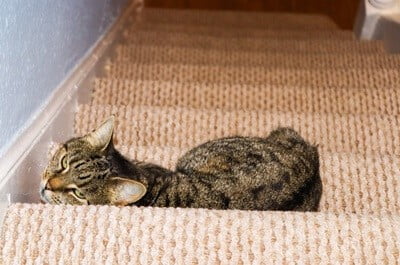Cats scratch to mark territory and keep their claws sharp. Carpeted stairs are a great place for this instinctual activity. Unlike other parts of the home, stairs have not been claimed by human occupants.
Train your cat out of scratching the staircase carpet by providing alternative scratching surfaces, such as cat trees and posts. Teach your cat that scratching is fine, but only on appropriate surfaces.
Do not tear the carpet up from your staircase. The cat will scratch at the wood beneath. Instead, focus on training and providing suitable alternatives. Any cat can be trained to temper its scratching instincts.
Why Does My Cat Scratch The Stair Carpet?
Scratching is an everyday activity for most cats. Cats love to scratch at the carpet. Reasons for the behavior include:
- Marking territory
- Sharpening claws
- Filing down long claws
- Relieving stress and tension
- Attention-seeking
Most often, the cat is claiming territory. The sight of the scratches will pair with the scent in a cat’s paw pads. This means that other cats know that your feline has claimed the territory.
Your cat will also be sharpening its claws. When hunting, felines like to remain stealthy. This involves moving low to the ground. Sharp claws help a cat dig into the ground and pull its bodyweight along. By scratching, a cat removes dead outer sheathes from its claws.
If your cat scratches carpet throughout the home, there will be an emotional explanation. Your cat is likely stressed or seeking your attention. Many cats will focus their scratching behavior on one location. Most owners report that the carpet on a staircase is a frequent target.
Your cat may also be scratching to get your attention. If you ever spot this behavior, you will immediately stop it. If a cat feels neglected, it will do whatever it can to get you to take notice of it. Your cat now knows how to get your attention with unwelcome behaviors, such as scratching.
How to Keep Cats From Scratching Stair Carpets
Offer alternative products that will satisfy your cat’s basic desire to scratch the carpet. Scratching trees and mats, located in territory that the cat considers its own, are essential. With other training techniques, your cat will soon lose interest in the stair carpet.

Personal Territory
Assign your cat with its own territory. If possible, this should be an entire room that you rarely enter. A spare bedroom is ideal. If this is not an option, consider a laundry room or storage facility.
When your cat starts scratching the stairs, issue a command to cease the behavior. A short, sharp noise that gets your cat’s attention will work. Then, pick up your cat and move it to its new territory.
Before attempting this, ensure that the room is feline-friendly. You cannot allow your cat to think that it is being punished for scratching the carpet. As scratching is so instinctive, your cat will not understand and deem this unfair. It’s a bit like punishing a cat for meowing or grooming.
Fill the room with toys, a cat tree, a litter tray, and scratching surfaces. The purpose of this training is to help your cat to understand that this is the only place where scratching is appropriate.
Scratching Substrates
The Journal of Feline Medicine and Surgery surveyed 4,331 owners about scratching substrate preferences. The carpet was a cat’s preferred option.
Senior cats were particularly interested in scratching the carpet. This is presumably due to the softer material under their claws. It was found that other cats gravitated more toward scratching rope.
The study found that the most successful form of scratching substrate was a vertical cat tree. Cats preferred trees with at least two platforms that were approximately 3 feet in height. If your cat has its own undisputed scratching substrates, it will likely embrace them.
The study confirmed that unwelcome scratching ceased with the addition of substrates. Cats do not want to damage your property, but they want somewhere to exercise their basic instincts.
As your cat scratches, you will notice trees and posts becoming ragged and worn. This is how your cat likes it. Your cat’s scent will be all over the rope. Do not throw away these toys and replace them, or you may have to start training your cat all over again.
Blocking Access to Stairs
If your cat cannot reach the stair carpet, it cannot scratch it. You could try placing a baby gate in front of the stairs. You can still use the stairs, but the carpet is more likely to be safe from your cat’s unwelcome attention.
This will divert your cat’s attention away from the staircase. It will not resolve the cat’s instinct to scratch, though. This means that this technique could backfire if not used in conjunction with training. The cat will look for something else to scratch.
This is why alternative substrates are so important. Unable to reach its preferred spot, the cat will use scratching posts instead. Over time, the cat will lose interest in scratching the stair carpet. At this stage, you can remove the barrier, but you should monitor the situation closely.
Consider the logistics of restricting stair access to cats. Keeping a senior cat on the lower floor may actually be beneficial. It can lead to less unnecessary movement, which can be a good thing if your cat has stiff back legs.
Deterrent Scents and Surfaces
You can keep your cat away from the staircase carpet with unappealing scents and textures. Ensure your cat has somewhere else to scratch. If you do not provide a surface, your cat will find one.
Scents
Cats have an incredible sense of smell. A barely perceptible aroma to a human can be overpowering to a feline. If the cat dislikes the smell of your stairs, it will likely avoid them at all costs.
On the one hand, this means no more scratching. On the other, the scent may permeate the entire home, causing your cat stress and anxiety. If you decide to use scent deterrent, cats dislike the following aromas:
- Citrus (lemon, orange, and lime juice)
- Eucalyptus
- Rosemary
- Lavender
- Thyme
- Cinnamon
Mix a small amount of one of these scents with water. Put the mix in a spray bottle and apply it to the stairs.
Surfaces
Cats dislike the feel of certain surfaces and textures beneath their paws. This will cause less distress to your cat.
Unlike scents, surfaces can be restricted to a small area. The following materials and sensations will deter a cat from scratching:
- Heavy plastic
- Aluminum foil
- Sticky substances, such as double-sided sticky tape
- Carpet runners
Limit the placement of these textures to the bottom stair, or where the cat likes to scratch. This will usually more than enough to deter your cat.

Managing Stress and Anxiety
If your cat does not restrict scratching to the stairs, stress is likely to be responsible. Applied Animal Behavior Science links scratching and destructive behavior to feelings of anxiety.
A cat with generalized anxiety is less likely to destructive. These cats will prefer to hide in dark places and avoid human contact. Your cat’s stress is likely stemming from a lack of attention and stimulation. Cats with separation anxiety, in particular, may act destructively.
Schedule a strict timetable as cats draw comfort from routine and familiarity. Feed, pet, and play with your cat at the same time each day. Before long, your cat will understand that this is its daily routine.
Spaying And Neutering
If you have not done so already, have your cat spayed or neutered. This is particularly advisable in male cats as unfixed males are highly territorial. The cat will be driven to scratch and claim territory, and testosterone makes male cats prone to destructive behavior.
Spaying and neutering will make the re-education process easier. The cat’s territorial instincts will not be as strong as they were previously. This will make your cat more agreeable to training and behavioral modification.
Declawing
Declawing a cat (onychectomy) is the process is surgically removing a cat’s claws. In theory, a cat with no claws cannot scratch surfaces. Unfortunately, an onychectomy is not just a manicure for cats.
An onychectomy involves amputating the bone at the tip of each toe. This is like cutting off your finger at the top knuckle. As a result, declawing cats is a controversial practice that leaves cats less able to defend themselves.
Some vets will not consider an onychectomy unless it is required to save the cat’s life. The process is painful and has long-term repercussions.
A cat that experiences an onychectomy will likely display different behavioral problems. The Journal of the American Veterinary Medical Association explains how a declawed cat is 3 times likelier to eliminate outside the litter box. The cat will also struggle to walk afterward as claws aid the natural gait. In short, it just introduces new problems.
Scratching is an instinctive behavior for cats. It is rarely born of a desire to destroy your possessions. With training, a cat can be taught to stop scratching carpet on stairs and expensive leather furniture.


Thank you! I’m excited to try aluminum foil on the stairs, or citrus. She already has lots of scratching posts. I’ll also give her more attention just in case. She seems to dislike human attention except certain times each day.